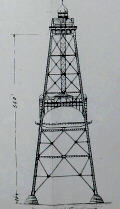From our current stock of books for sale:
SYDNEY HARBOUR BRIDGE ADVISORY BOARD
Report on designs and tenders submitted in connection with the proposed bridge over Sydney Harbour to connect Sydney with North Sydney.New South Wales, 1903

Stewart's scheme for the Sidney Harbour Bridge, 1903
Description
Throughout the 19th century, there were numerous efforts to build a bridge across Sydney Harbour, but the first major step towards the realisation of the project came with the holding of a competition in 1900. The conditions called for a single-span road and rail bridge with headroom of not less than 180ft above high water for 600 feet of the span, though material and form was left open. The resulting entries, all submitted anonymously under a motto ('United Sydney', 'Floreat Etona', 'Wait and Hope' etc.), vary enormously. There is a parabolic truss bridge with a 900ft central span, a 3-hinged arched bridge of 1880ft span, several suspension bridges, a combined arch and suspension bridge, a balanced cantilever bridge with suspensed span and so on. They were all rejected. In 1901, the conditions were re-issued, but in a far more detailed form and now calling for a bridge of overall length of 3000ft, with a clear central span of at least 1200ft with headroom nearly as before. Also specified were the gradients, arrangement and character of deck and, as far as possible, the foundations, as well as the material. Design loadings for the structure and allowable stresses in the material were also given. This time, the firms which submitted designs were named. They include William Arrol & Co, Cleveland Bridge & Engineering Co, Alexander Findlay & Co, E & C Bridge Co, Fives-Lille Co, and the Australian firms of Gilbert Weaver, and J Stewart & Co (which submitted 6 schemes). The designs, as before, were for a variety of arched, cantilever, suspension or combination structures and again they were all turned down. However, three of the firms, Arrol, E & C Bridge Co and Stewart, were asked to resubmit designs to amended tenders, and finally one of Stewart's schemes was selected.

From Stewart's scheme |
Designed in partnership with the German firm of M A N, it was a continuous, latticed-truss bridge, varying in depth from 200 feet over the supports to 50 feet at the centre of the span and at the abutments. Stewart's also submitted ten alternative methods of making the foundations, including a freezing process. But alas, the Government fell just before this lengthy report with its recommendation appeared, and the incoming government rejected the whole project, which lapsed until 1922, when an act was passed authorising the building of a bridge across the harbour. The report covers the whole history of this early competition, and is a document of absorbing interest. Most of the entries are illustrated and the serious contenders of 1902 and 1903 discussed in some detail, with reasons given for their unsuitability. Both sets of conditions are, of course, included, and there are minutes of evidence taken from naval personnel and from some of the engineers involved, notably J L Turk of the E & C Bridge Co and Norman Selfe of J Stewart & Co, particularly over the question of the freezing process, which had never before been used for bridge foundations, though it had been used to sink mine shafts. The final design of the luckless J Stewart & Co is illustrated in full, together with maps showing approach roads, cross sections and so on.
Collation
4to. 67 + (3)pp, 45 fldg. plts of elevations and diagrams numbered 1-13, 1-7 and the remainder un-numbered. Contemporary full leather, rather worn, head and foot of spine bumped. 1 plate neatly repaired for tear.Price
£950.00Catalogue No: 1758
